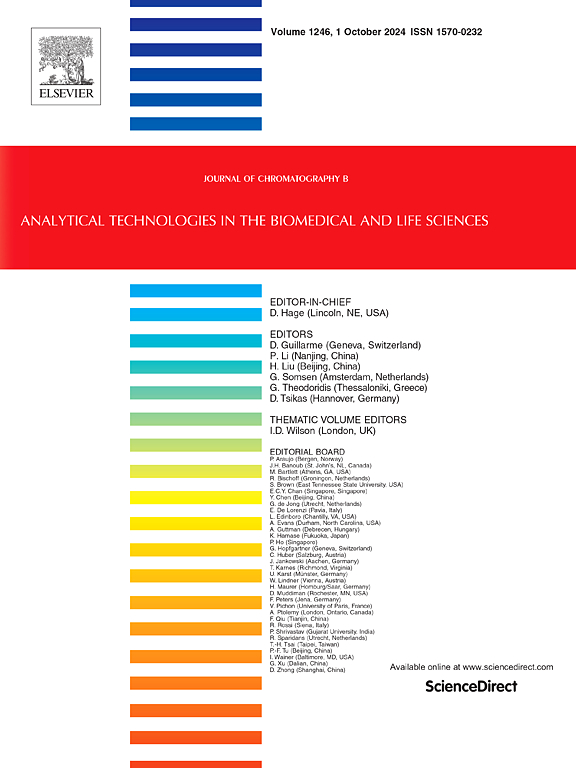Development and application of a quantitative LC-MS/MS assay for the analysis of four dental local anesthetics in human plasma and breast milk
IF 2.8
3区 医学
Q2 BIOCHEMICAL RESEARCH METHODS
引用次数: 0
Abstract
Local anesthetics (LAs: articaine, lidocaine, bupivacaine, and mepivacaine) are essential for dental pain management. However, there are concerns that the lipophilic LAs could cross into breast milk causing toxicity to the infant. Our objective was to establish a multi-analyte LC-MS/MS method for the concurrent quantification of local anesthetics (LAs) in human plasma and breast milk, clarifying the transfer of LAs from plasma to breast milk, thereby offering crucial data for the safe assessment of LAs during the nursing period. Sample preparation for plasma and breast milk involved protein precipitation and a single dilution step. The chromatographic analysis was conducted using an ACQUITY UPLC BEH C18 column. Detection was facilitated by a triple quadrupole mass spectrometer employing positive electrospray ionization. The method demonstrated excellent linearity for articaine, mepivacaine, and bupivacaine across the range of 0.5 to 500 ng/mL, and for lidocaine from 1.0 to 1000 ng/mL in both plasma and breast milk, with correlation coefficients (R2) of 0.99 or higher. The method was effectively utilized in the analysis of samples from three nursing mothers who received dental treatment involving LAs. Articaine and lidocaine excretion in milk was confirmed, but it presented no significant safety risks to the breastfed infants.
开发和应用一种定量 LC-MS/MS 分析法,用于分析人体血浆和母乳中的四种牙科局部麻醉剂。
局部麻醉剂(LAs:阿替卡因、利多卡因、布比卡因和甲哌卡因)对牙科疼痛治疗至关重要。然而,人们担心亲脂性局部麻醉剂可能会进入母乳,对婴儿造成毒性。我们的目标是建立一种多分析物 LC-MS/MS 方法,用于同时定量检测人体血浆和母乳中的局麻药(LAs),澄清 LAs 从血浆转移到母乳的情况,从而为哺乳期安全评估 LAs 提供重要数据。血浆和母乳样品的制备包括蛋白质沉淀和单一稀释步骤。色谱分析采用 ACQUITY UPLC BEH C18 色谱柱。三重四极杆质谱仪采用正电喷雾离子化技术进行检测。该方法对血浆和母乳中0.5-500 ng/mL的阿替卡因、甲哌卡因和布比卡因以及1.0-1000 ng/mL的利多卡因均具有良好的线性关系,相关系数(R2)均在0.99以上。该方法被有效地用于分析三位接受过涉及 LAs 的牙科治疗的哺乳母亲的样本。证实了阿替卡因和利多卡因在乳汁中的排泄量,但对母乳喂养的婴儿没有明显的安全风险。
本文章由计算机程序翻译,如有差异,请以英文原文为准。
求助全文
约1分钟内获得全文
求助全文
来源期刊

Journal of Chromatography B
医学-分析化学
CiteScore
5.60
自引率
3.30%
发文量
306
审稿时长
44 days
期刊介绍:
The Journal of Chromatography B publishes papers on developments in separation science relevant to biology and biomedical research including both fundamental advances and applications. Analytical techniques which may be considered include the various facets of chromatography, electrophoresis and related methods, affinity and immunoaffinity-based methodologies, hyphenated and other multi-dimensional techniques, and microanalytical approaches. The journal also considers articles reporting developments in sample preparation, detection techniques including mass spectrometry, and data handling and analysis.
Developments related to preparative separations for the isolation and purification of components of biological systems may be published, including chromatographic and electrophoretic methods, affinity separations, field flow fractionation and other preparative approaches.
Applications to the analysis of biological systems and samples will be considered when the analytical science contains a significant element of novelty, e.g. a new approach to the separation of a compound, novel combination of analytical techniques, or significantly improved analytical performance.
 求助内容:
求助内容: 应助结果提醒方式:
应助结果提醒方式:


